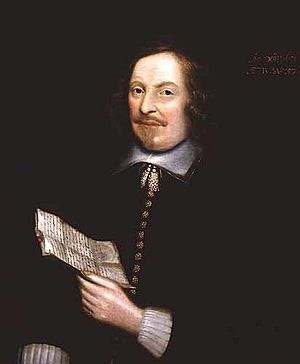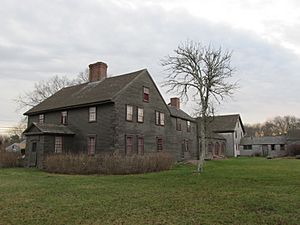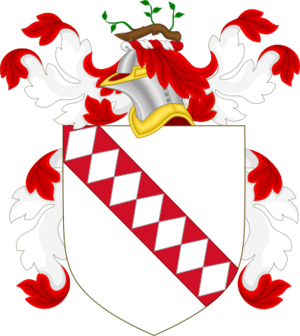Edward Winslow facts for kids
Quick facts for kids
Edward Winslow
|
|
|---|---|
 |
|
| 3rd Governor of Plymouth Colony | |
| In office 1633–1634 |
|
| Preceded by | William Bradford |
| Succeeded by | Thomas Prence |
| 6th Governor of Plymouth Colony | |
| In office March 1, 1636 – March 7, 1637 |
|
| Preceded by | William Bradford |
| Succeeded by | William Bradford |
| 10th Governor of Plymouth Colony | |
| In office June 3, 1639 – June 5, 1644 |
|
| Preceded by | William Bradford |
| Succeeded by | William Bradford |
| Commissioner for Plymouth Colony | |
| In office 1643–1644 Serving with William Collier (1643)
John Brown (1644) |
|
| Personal details | |
| Born | 18 October 1595 Droitwich, Worcestershire, England |
| Died | 8 May 1655 (aged 59) Near Jamaica |
| Profession | Politician and governor |
| Signature |  |
Edward Winslow (born October 18, 1595 – died May 8, 1655) was an important English leader. He was a Separatist, meaning he wanted to separate from the Church of England. He traveled to America on the famous ship, the Mayflower, in 1620.
Edward Winslow was one of the main leaders on the Mayflower. He also became a key figure in Plymouth Colony. Both he and his brother, Gilbert Winslow, signed the Mayflower Compact. This was an important agreement for the new colony.
In Plymouth, Edward Winslow held many important jobs. He was an assistant governor and served as governor three times. He also acted as the colony's representative in London. He wrote several important books about the early days of the colony. These include Good Newes from New England and Mourt's Relation. The latter describes the first Thanksgiving celebration.
Edward Winslow is the only original Plymouth colonist whose portrait was painted while he was alive. This portrait is now at the Pilgrim Hall Museum in Plymouth, Massachusetts. He died in 1655 from a fever while on a trip in the Caribbean.
Contents
Edward Winslow's Early Life in England
Edward Winslow was born on October 18, 1595, in Droitwich, England. He was baptized two days later. His parents were Edward Winslow Sr. and Magdalene Oliver. Edward Sr. was involved in the salt trade. The Winslow family had lived in Worcestershire since at least the 1500s.
Edward had four younger brothers: Gilbert, John, Josiah, and Kenelm. Gilbert traveled with Edward on the Mayflower. His other brothers later followed him to America.
From 1606 to 1611, Edward attended the King's School, Worcester. In 1613, he became an apprentice to a printer in London. However, he did not finish his apprenticeship. Around 1617, he moved to Leiden, Holland. He went there to join a group of English Separatists.
Life in Leiden, Holland (1617–1620)
In Leiden, Edward Winslow joined the English Separatist church. He helped Elder William Brewster with his secret printing work. In 1618, Winslow and Brewster printed a religious book called Perth Assembly. This book criticized the English king and his church. King James I was very angry and ordered Brewster's arrest. Brewster had to hide, which made it hard for the Pilgrims to prepare for their journey to America.
On April 27, 1618, Winslow married Elizabeth Barker in Leiden. He quickly became a leader among the English exiles. In June 1620, Winslow was one of four men who wrote a letter about the Pilgrims' trip to America. This letter was sent to their agents in London. The preparations for the trip were difficult and expensive.
The Mayflower Journey

Edward Winslow and his wife Elizabeth were part of the Separatist group. They wanted to leave England to practice their religion freely. The merchant Thomas Weston helped them by providing the ship Mayflower.
Edward's brother Gilbert also traveled on the Mayflower. The Winslow family also brought a servant, George Soule, and a young boy named Elias Story. They also cared for Elinor More, an eight-year-old girl. Elinor was one of four More children traveling without their parents. Sadly, Elinor died during the first winter in the colony.
The Mayflower left Plymouth, England, on September 6, 1620. The ship was about 100 feet long. It carried 102 passengers and about 30 crew members. Conditions on board were very crowded. After two months, strong storms hit the ship. Water leaked in, and passengers were often wet and sick. Many people became ill due to poor food and unsanitary conditions. Two people died during the voyage.
On November 9, 1620, after about three months at sea, they saw land. It was Cape Cod. They tried to sail south to their planned destination in Virginia. But strong winter seas forced them back to Cape Cod. They anchored in Provincetown Harbor on November 11. On that day, the famous Mayflower Compact was signed.
Life in Plymouth Colony
| Governors of Plymouth Colony | ||
|---|---|---|
| Dates | Governor | |
| 1620 | John Carver | |
| 1621–1632 | William Bradford | |
| 1633 | Edward Winslow | |
| 1634 | Thomas Prence | |
| 1635 | William Bradford | |
| 1636 | Edward Winslow | |
| 1637 | William Bradford | |
| 1638 | Thomas Prence | |
| 1639–1643 | William Bradford | |
| 1644 | Edward Winslow | |
| 1645–1656 | William Bradford | |
| 1657–1672 | Thomas Prence | |
| 1673–1679 | Josiah Winslow | |
| 1680–1692 | Thomas Hinckley | |
The colonists were not well prepared for the harsh New England winter. More than half of them died from hunger, disease, and the cold. In the spring of 1621, Winslow and the other survivors celebrated what is now known as the first Thanksgiving.
Everyone worked hard to build homes and find food. The merchant Thomas Weston criticized them for not sending enough goods back to England. Governor William Bradford wrote back, explaining their struggles. He said that Governor Carver had worked himself to death.
The next year, the ship Fortune arrived. But it did not bring enough supplies for the colony. Even with winter coming, the colonists bravely faced the challenge. They managed to load the Fortune with furs and other goods. This cargo would have paid off much of their debt. However, French privateers attacked the ship near England and stole everything.
On March 24, 1621, Edward Winslow's wife, Elizabeth, died. Just a month and a half later, on May 12, 1621, Edward Winslow married Susanna White. Susanna was a widow with two sons, Resolved and Peregrine. Peregrine was the first English child born in the colony. Edward and Susanna were the first couple to marry in Plymouth Colony. They had three sons, one daughter, and one child who died young.
Edward Winslow's Leadership and Later Life

Edward Winslow made several trips back to England in the 1620s. He served as an ambassador for the Pilgrims. He also negotiated with the people who funded the colony. In 1624, he brought the first cattle to Plymouth. These cows and a bull came from Devon, England. Their descendants became the American Milking Devon breed. These animals were very valuable for milk, meat, and as work oxen.
Winslow became good friends with the Native American leader Massasoit. Massasoit's people traded with the colonists. In 1629, Plymouth Colony gained new land for fishing and trading posts. This opened up new areas for the colonists.
In 1632, Winslow explored the Connecticut River. He is thought to have chosen the spot for the settlement that became Windsor.
Edward Winslow was a skilled diplomat. He represented Plymouth Colony to English officials. He served as governor of Plymouth for one-year terms in 1633–34, 1636–37, and 1644–45. In 1643, he was also a commissioner for the United Colonies of New England. This was a military group that united the different New England colonies.
In the early 1640s, England was in a civil war. Some settlers returned to England to join the fight against King Charles I. In 1646, Winslow began working for Oliver Cromwell. Cromwell later became the Lord Protector of England. After King Charles was executed in 1649, Edward Winslow planned to return to Plymouth. However, he became too involved in English affairs and never went back to Plymouth.
In 1654, Winslow was part of an English naval mission. They were fighting against the Spanish in the West Indies. They won the battle, but Winslow caught yellow fever. He died on May 7, 1655, near Jamaica.
Edward Winslow's Family
Edward Winslow married twice:
- Elizabeth Barker: They married in Leiden, Holland, in 1618. She died in Plymouth Colony on March 24, 1621. They had one child, Margaret Winslow. Elizabeth was buried at Cole's Hill Burial Ground in Plymouth.
- Susanna White (Jackson): They married on May 12, 1621, in Plymouth Colony. She was the daughter of Richard and Mary Jackson.
Children of Edward Winslow and Susanna White Jackson:
- An unnamed child born and died in 1622 or 1623.
- Edward Winslow – born around 1624.
- John Winslow – born around 1626.
- Josiah Winslow – born around 1627. He later became the 13th Governor of Plymouth Colony. Josiah married Penelope Pelham and had four children. He died in 1680.
- Elizabeth Winslow – born around 1631. She married Robert Brooks and later George Curwin.
Children of Susanna White's first marriage (Edward Winslow's stepsons):
- Resolved White – born around 1615. He married Judith Vassall and later Abigail Lord. He died in 1687.
- Peregrine White – born in late November 1620 on the Mayflower. He was the first English child born in that part of America. He married Sarah Bassett and had seven children. He died in 1704.
Death and Memorial
Edward Winslow was buried at sea in the Caribbean. This happened sometime after May 7, 1655, near Jamaica.
The Winslow Cemetery in Marshfield, Massachusetts, has a stone monument. It honors "The Settlers of Green Harbor Marshfield." Edward Winslow's name is on it, along with his wife Susanna and her sons Resolved and Peregrine. There is also a special memorial stone for Edward Winslow in the cemetery.
Edward Winslow's Writings
Edward Winslow's writings are very important for understanding the history of Plymouth Colony. Some of his works include:
- Good Newes from New England (1624) – This book gave a true account of events in Plymouth.
- Hypocrisie Unmasked (1646) – This book included a chapter about why the New England colony was first started.
- New England's Salamander (1647).
- The Danger of Tolerating Levelers in a Civil State (1649).
- The Glorious Progress of the Gospel amongst the Indians in New England (1649) – He wrote this with John Eliot and Thomas Mayhew Jr.
Edward Winslow and William Bradford are believed to have written a journal. It was published in 1622 and is known as Mourt's Relation. This journal describes the beginning of the English settlement at Plymouth.
Images for kids
See also
 In Spanish: Edward Winslow para niños
In Spanish: Edward Winslow para niños




